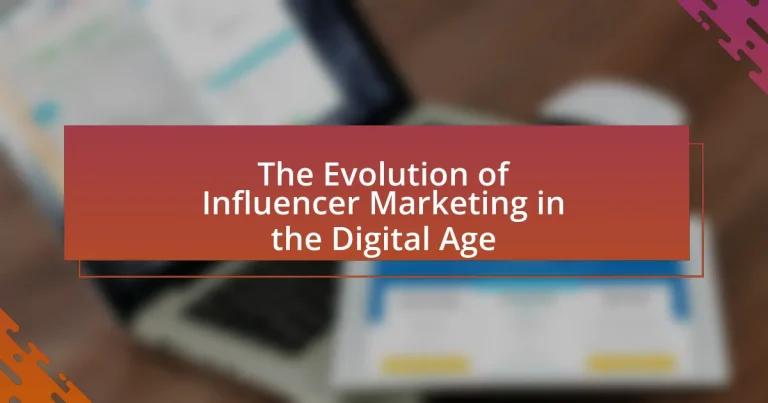The article focuses on the evolution of influencer marketing in the digital age, highlighting its transition from celebrity endorsements to collaborations with micro and nano influencers. It examines the significant impact of social media platforms on marketing strategies, emphasizing the importance of authenticity and audience alignment in driving consumer engagement. Key components of successful influencer marketing campaigns, such as influencer selection, content creation, and performance measurement, are discussed, along with the challenges brands face, including authenticity issues and regulatory compliance. The article also explores future trends, emerging platforms, and best practices for brands to enhance their influencer marketing efforts.

What is Influencer Marketing in the Digital Age?
Influencer marketing in the digital age is a strategy where brands collaborate with individuals who have a significant online following to promote products or services. This approach leverages the trust and engagement that influencers have built with their audiences, making it an effective way to reach target demographics. According to a 2021 survey by the Digital Marketing Institute, 49% of consumers depend on influencer recommendations, highlighting the impact of influencer marketing on consumer behavior.
How has influencer marketing evolved over the years?
Influencer marketing has evolved significantly over the years, transitioning from celebrity endorsements to a diverse ecosystem of micro and nano influencers. Initially, brands relied heavily on high-profile celebrities to promote products, but as social media platforms grew, the focus shifted towards individuals with smaller, more engaged audiences. According to a 2021 report by Influencer Marketing Hub, 90% of marketers found influencer marketing effective, highlighting its increasing importance in digital marketing strategies. This evolution reflects a broader trend where authenticity and relatability have become key factors in consumer engagement, leading brands to prioritize influencers who resonate more closely with niche audiences.
What were the early forms of influencer marketing?
Early forms of influencer marketing included celebrity endorsements and sponsorships, where brands collaborated with well-known figures to promote products. In the 1980s and 1990s, companies like Nike and Coca-Cola utilized athletes and entertainers to reach broader audiences, leveraging their popularity to build brand credibility. This approach was effective as it capitalized on the trust and admiration that consumers had for these public figures, leading to increased sales and brand loyalty.
How did social media platforms change influencer marketing?
Social media platforms transformed influencer marketing by enabling direct engagement between brands and consumers through influencers, significantly increasing reach and authenticity. Platforms like Instagram and TikTok allow influencers to create relatable content that resonates with their audience, fostering trust and driving purchasing decisions. According to a 2021 survey by the Digital Marketing Institute, 49% of consumers rely on influencer recommendations for their purchasing choices, highlighting the effectiveness of this marketing strategy. Additionally, the rise of micro-influencers, who often have smaller but highly engaged followings, has shifted brand partnerships towards more niche audiences, further enhancing targeted marketing efforts.
Why is influencer marketing important today?
Influencer marketing is important today because it effectively leverages the trust and reach of individuals with significant social media followings to promote products and services. This marketing strategy capitalizes on the fact that 49% of consumers depend on influencer recommendations when making purchasing decisions, as reported by a study from the Digital Marketing Institute. Additionally, influencer marketing generates 11 times higher ROI than traditional forms of digital marketing, highlighting its effectiveness in engaging target audiences and driving sales.
What role do influencers play in consumer decision-making?
Influencers significantly shape consumer decision-making by acting as trusted sources of information and recommendations. Their ability to connect with audiences on a personal level fosters trust, which in turn influences purchasing behavior. Research indicates that 49% of consumers rely on influencer recommendations when making purchase decisions, highlighting their impact on brand perception and consumer choices. Additionally, influencers often create authentic content that resonates with their followers, further driving engagement and conversion rates. This dynamic illustrates the critical role influencers play in guiding consumer preferences in the digital marketplace.
How does influencer marketing compare to traditional advertising?
Influencer marketing is generally more effective than traditional advertising due to its ability to engage audiences authentically. Influencers often have established trust with their followers, leading to higher engagement rates; for instance, influencer posts can achieve engagement rates of 1% to 3%, while traditional ads typically see rates below 0.1%. Additionally, influencer marketing allows for targeted outreach to specific demographics, as influencers often cater to niche markets, enhancing the relevance of the message. This targeted approach contrasts with traditional advertising, which often relies on broad audience reach without the same level of personalization.

What are the key components of influencer marketing?
The key components of influencer marketing include influencer selection, audience alignment, content creation, and performance measurement. Influencer selection involves identifying individuals whose reach and credibility resonate with the target audience, ensuring they align with the brand’s values and objectives. Audience alignment is crucial, as the influencer’s followers should match the brand’s target demographic to maximize engagement and conversion rates. Content creation focuses on developing authentic and engaging material that reflects both the influencer’s style and the brand’s messaging, fostering a genuine connection with the audience. Finally, performance measurement assesses the effectiveness of the campaign through metrics such as engagement rates, reach, and return on investment, allowing brands to refine their strategies for future initiatives. These components collectively drive the success of influencer marketing campaigns in the digital landscape.
How do brands select the right influencers?
Brands select the right influencers by analyzing their audience alignment, engagement rates, and content relevance. This process involves identifying influencers whose followers match the brand’s target demographic, ensuring that the influencer’s audience is likely to be interested in the brand’s products or services. Additionally, brands assess engagement rates, as higher interaction levels indicate a more active and interested audience. Content relevance is also crucial; brands look for influencers whose content style and values resonate with their own brand identity. Research shows that 49% of consumers depend on influencer recommendations, highlighting the importance of selecting influencers who can authentically connect with their audience.
What criteria should brands consider when choosing influencers?
Brands should consider the influencer’s audience demographics, engagement rates, content relevance, authenticity, and alignment with brand values when choosing influencers. Audience demographics ensure that the influencer’s followers match the brand’s target market, while engagement rates indicate how actively the audience interacts with the influencer’s content. Content relevance is crucial for maintaining brand consistency, and authenticity builds trust with the audience. Lastly, alignment with brand values ensures that the influencer’s image resonates positively with the brand’s identity, enhancing the effectiveness of the marketing campaign.
How does audience alignment impact influencer selection?
Audience alignment significantly impacts influencer selection by ensuring that the influencer’s followers match the target demographic of the brand. When brands choose influencers whose audiences reflect their own customer base, they increase the likelihood of engagement and conversion. For instance, a study by Influencer Marketing Hub found that campaigns with well-aligned audiences can achieve up to 11 times higher ROI compared to those without alignment. This alignment fosters authenticity and trust, as audiences are more receptive to messages from influencers who genuinely resonate with their interests and values.
What types of influencer marketing strategies exist?
Influencer marketing strategies include various approaches such as sponsored content, affiliate marketing, product collaborations, and brand ambassadorships. Sponsored content involves influencers creating posts that promote a brand or product for compensation, which is a widely used method to reach target audiences effectively. Affiliate marketing allows influencers to earn commissions by promoting products and sharing unique referral links, incentivizing them to drive sales. Product collaborations involve influencers co-creating products with brands, leveraging their creativity and audience trust to enhance brand visibility. Brand ambassadorships establish long-term relationships between brands and influencers, where influencers consistently promote the brand over time, fostering loyalty and authenticity. These strategies are supported by data indicating that 49% of consumers depend on influencer recommendations for purchasing decisions, highlighting their effectiveness in modern marketing.
What are the differences between micro and macro influencers?
Micro influencers typically have between 1,000 to 100,000 followers, while macro influencers possess over 100,000 followers. Micro influencers often engage with niche audiences, leading to higher engagement rates, with studies showing that they can achieve engagement rates of up to 7%, compared to macro influencers who average around 1-3%. Additionally, micro influencers are perceived as more relatable and authentic, which can enhance trust among their followers. In contrast, macro influencers usually have broader reach and visibility, making them suitable for large-scale brand campaigns.
How can brands leverage different platforms for influencer marketing?
Brands can leverage different platforms for influencer marketing by tailoring their strategies to the unique characteristics and audience demographics of each platform. For instance, on Instagram, brands can utilize visually appealing content and stories to engage users, while on TikTok, they can create short, entertaining videos that resonate with a younger audience. Research indicates that 49% of consumers depend on influencer recommendations on social media, highlighting the effectiveness of these platforms in reaching target demographics. Additionally, brands can analyze engagement metrics across platforms to optimize their campaigns, ensuring they maximize reach and impact.

What challenges does influencer marketing face in the digital age?
Influencer marketing faces several challenges in the digital age, including authenticity issues, market saturation, and regulatory compliance. Authenticity concerns arise as audiences increasingly question the credibility of influencers, particularly when sponsored content is not clearly disclosed. Market saturation occurs as more brands engage influencers, leading to diminished impact and increased competition for audience attention. Regulatory compliance challenges stem from evolving advertising standards and guidelines, such as the Federal Trade Commission’s requirements for transparency in endorsements, which can complicate partnerships and campaigns. These challenges necessitate strategic approaches to maintain effectiveness and trust in influencer marketing.
How do authenticity and trust impact influencer marketing?
Authenticity and trust significantly enhance the effectiveness of influencer marketing by fostering genuine connections between influencers and their audiences. When influencers are perceived as authentic, their followers are more likely to trust their recommendations, leading to higher engagement rates and conversion levels. A study by the Digital Marketing Institute found that 70% of millennials are influenced by the recommendations of their peers in purchasing decisions, highlighting the importance of trust in this marketing strategy. Furthermore, brands that collaborate with authentic influencers experience a 37% higher engagement rate compared to those who do not, demonstrating that authenticity and trust are critical components in driving successful influencer marketing campaigns.
What are the risks of influencer fraud?
Influencer fraud poses significant risks to brands, including financial loss, reputational damage, and ineffective marketing campaigns. Financially, brands may invest in influencers who do not deliver genuine engagement or conversions, leading to wasted advertising budgets. Reputationally, association with fraudulent influencers can harm a brand’s image, as consumers may perceive the brand as untrustworthy. Additionally, ineffective marketing campaigns result from misleading metrics, such as inflated follower counts or engagement rates, which do not accurately reflect an influencer’s true reach or impact. According to a 2021 report by the Association of National Advertisers, 75% of marketers have encountered influencer fraud, highlighting the prevalence and seriousness of this issue in the digital marketing landscape.
How can brands ensure transparency in influencer partnerships?
Brands can ensure transparency in influencer partnerships by implementing clear disclosure guidelines and maintaining open communication with influencers. Clear disclosure involves requiring influencers to use specific hashtags, such as #ad or #sponsored, to indicate paid partnerships, which aligns with Federal Trade Commission (FTC) regulations. Open communication fosters trust and allows brands to set expectations regarding content authenticity and audience engagement. According to a 2021 survey by the Influencer Marketing Hub, 70% of consumers prefer influencers who are transparent about their partnerships, highlighting the importance of honesty in building brand credibility.
What legal considerations should brands be aware of?
Brands should be aware of several legal considerations, including advertising regulations, intellectual property rights, and data privacy laws. Advertising regulations, such as the Federal Trade Commission (FTC) guidelines in the United States, require brands to disclose paid partnerships and sponsorships clearly to avoid misleading consumers. Intellectual property rights protect brands’ trademarks and copyrighted materials, necessitating that brands ensure they have the right to use any content created by influencers. Data privacy laws, such as the General Data Protection Regulation (GDPR) in Europe, mandate that brands handle consumer data responsibly and obtain consent for data collection and processing. These legal frameworks are essential for brands to navigate the complexities of influencer marketing effectively and avoid potential legal repercussions.
What regulations govern influencer marketing practices?
Influencer marketing practices are primarily governed by regulations set forth by the Federal Trade Commission (FTC) in the United States. The FTC requires influencers to disclose any material connections with brands, meaning they must clearly indicate when they are being compensated for promoting products or services. This regulation aims to ensure transparency and protect consumers from misleading advertising. The FTC’s guidelines specify that disclosures should be clear and conspicuous, and they have taken enforcement actions against influencers and brands that fail to comply, reinforcing the importance of these regulations in maintaining ethical marketing practices.
How can brands protect themselves from legal issues?
Brands can protect themselves from legal issues by implementing comprehensive compliance strategies that include clear contracts, adherence to advertising regulations, and thorough vetting of influencers. Establishing detailed contracts ensures that both parties understand their responsibilities and liabilities, which can mitigate disputes. Adhering to advertising regulations, such as the Federal Trade Commission guidelines in the United States, helps brands avoid misleading claims and ensures transparency in sponsored content. Additionally, conducting due diligence on influencers, including reviewing their past collaborations and audience engagement, can prevent associations with individuals who may pose reputational risks. These measures collectively reduce the likelihood of legal challenges and enhance brand integrity in the evolving landscape of influencer marketing.
What are the future trends in influencer marketing?
Future trends in influencer marketing include the rise of micro and nano influencers, increased focus on authenticity, and the integration of artificial intelligence for targeted campaigns. Micro and nano influencers, who typically have smaller but highly engaged audiences, are becoming more valuable as brands seek genuine connections with consumers. A study by the Digital Marketing Institute found that 82% of consumers are more likely to trust a brand when it is endorsed by a micro-influencer. Additionally, brands are prioritizing authentic content over polished advertisements, as 90% of consumers value authenticity in influencer partnerships, according to a survey by Stackla. Lastly, the use of AI tools for data analysis and audience targeting is expected to grow, enabling brands to optimize their influencer strategies effectively.
How is technology shaping the future of influencer marketing?
Technology is significantly shaping the future of influencer marketing by enabling more precise targeting and enhancing engagement through data analytics and artificial intelligence. Advanced algorithms allow brands to identify influencers whose audiences align closely with their target demographics, increasing the effectiveness of campaigns. For instance, a study by Influencer Marketing Hub in 2021 revealed that 63% of marketers planned to increase their influencer marketing budgets, largely due to the improved ROI facilitated by technology. Additionally, platforms like Instagram and TikTok are integrating shopping features, allowing influencers to directly sell products, which streamlines the purchasing process for consumers and boosts sales for brands. This integration of technology not only enhances the influencer’s role but also transforms how brands interact with their audiences, making influencer marketing more data-driven and efficient.
What emerging platforms should brands consider for influencer marketing?
Brands should consider TikTok, Clubhouse, and Twitch as emerging platforms for influencer marketing. TikTok has rapidly gained popularity, boasting over 1 billion monthly active users, making it a prime space for brands to engage younger audiences through short, creative video content. Clubhouse, with its audio-based format, allows brands to connect with consumers in real-time discussions, fostering deeper engagement. Twitch, primarily known for gaming, has expanded its reach to various content categories and attracts a highly engaged audience, making it an effective platform for brands targeting niche markets. These platforms offer unique opportunities for authentic influencer collaborations, aligning with current consumer trends towards interactive and immersive content.
What best practices should brands follow for successful influencer marketing?
Brands should prioritize authenticity, audience alignment, and measurable goals for successful influencer marketing. Authenticity ensures that influencers genuinely connect with their audience, which enhances trust and engagement; studies show that 92% of consumers trust recommendations from individuals over brands. Audience alignment involves selecting influencers whose followers match the brand’s target demographic, increasing the likelihood of effective communication and conversion. Additionally, setting measurable goals allows brands to assess the effectiveness of their campaigns, with 49% of marketers stating that measuring ROI is crucial for influencer marketing success. By adhering to these best practices, brands can optimize their influencer marketing strategies effectively.
How can brands measure the effectiveness of their influencer campaigns?
Brands can measure the effectiveness of their influencer campaigns through key performance indicators (KPIs) such as engagement rates, reach, conversion rates, and return on investment (ROI). Engagement rates, which include likes, comments, and shares, provide insight into how well the audience interacts with the content. Reach indicates the total number of unique users who see the campaign, while conversion rates measure the percentage of users who take a desired action, such as making a purchase or signing up for a newsletter. ROI quantifies the financial return generated from the campaign relative to its cost, allowing brands to assess overall effectiveness. According to a 2021 study by Influencer Marketing Hub, 63% of marketers reported that measuring ROI was their top challenge, highlighting the importance of these metrics in evaluating campaign success.
What strategies can enhance collaboration with influencers?
To enhance collaboration with influencers, brands should prioritize building authentic relationships through clear communication and mutual value. Establishing trust is essential; brands can achieve this by being transparent about campaign goals and expectations. Additionally, offering creative freedom allows influencers to produce content that resonates with their audience, leading to more genuine engagement. Research indicates that campaigns featuring authentic influencer partnerships yield a 37% higher engagement rate compared to traditional advertising methods. By focusing on these strategies, brands can foster effective and lasting collaborations with influencers.




